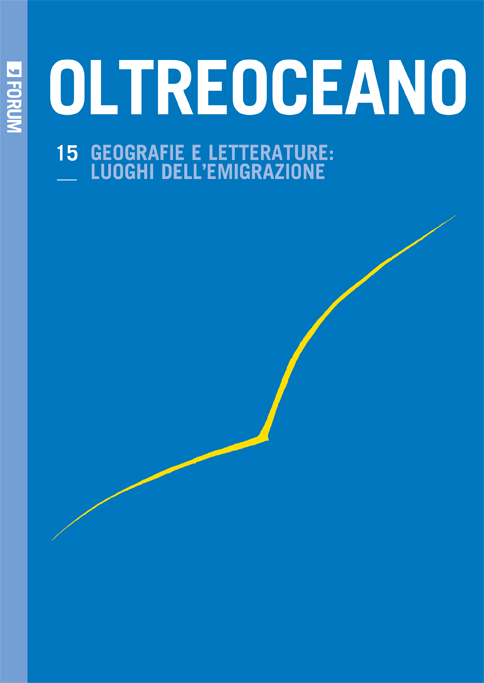American Antiquities and the Process of Ethnogenesis in the Early Republic
Keywords:
Earthworks, Mound-builders, farmers, Mississippi Valley, Ethnogenesis, NationbuildingAbstract
This essay discusses some of the literary expressions dealing with the gigantic earthworks which the first European immigrants and people from the Atlantic seaboard discovered in the Mississippi Valley, thus articulating the inchoate processes of ethnogenesis and nationbuilding in the early Republican period.
I tumuli della Valle del Mississippi e il loro ruolo nel processo della costruzione della nazione americana
L’articolo tratta delle espressioni letterarie che discutevano la presenza dei tumuli giganteschi scoperti nella ‘Mississippi Valley’ dai primi emigranti europei e americani provenienti dalla costa atlantica. Ciò formulò, nel primo periodo repubblicano, importanti processi di etnogenesi e ‘nation-building’.
Downloads
References
Atwater, C. (1833): Writings. Columbus: Scott and Wright Printers.
B. L. H. (1942): A Mississippi Panorama. Minnesota History, 23, 4, pp. 349-354.
Bryant, W.C. (1993): The Prairies. In J. Hollander (Ed.), American Poetry. The Nineteenth Century I (pp. 162-165). New York: The Library of America.
Eastman, M. (1849): Preface. In C. Kirkland, Dacohtah; or, Life and Legends of the Sioux around Fort Snelling (V-XI). New York: John Wiley.
Flagg, E. (1838): The Far West I-II. New York: Harper and Brothers.
Flagg, E. (1906): Early Western Travels 1748-1846, XXVI. In R. Gold Thwaits (Ed.). Cleveland: The Arthur H. Clark Company.
Flint, M. (1860: The Mounds of Cahokia. In W.T. Coggeshall (Ed.), Poets and Poetry of the West (pp. 57-58). Columbus: Follett, Foster and Company.
Frost, R. (2006): The Gift Outright. In D. Lehman (Ed.), The Oxford Book of American Poetry (p. 236). New York: Oxford University.
Griffiths, A. (2003): Shivers down your spine: panoramas and the origins of the cinema reenactment. Journal Screen, 44, 1, pp. 1-36.
Hall, The Hon. Judge (1828): Letters from the West (pp. 132-142). London: Henry Colburn.
Hall, The Hon. Judge (1906): The French Village. In C. S. Baldwin (Ed.), American Short Stories (pp. 99-114). New York: Longmans, Green.
Hantman, J. L. & Dunham, G. (1993): The Enlightened Archaeologist: Recent Excavations in Virginia Offer New Insight into Jefferson’s Study of an Indian Mound. Archaeology, 46, 3, p. 46.
Hawley, M. F. (2006): Frederick Jackson Turner, Archaeologist? North American Archaeologist, 27, 3, pp. 271-282.
Jefferson, T. (1984): Notes on the State of Virginia. In M.D. Peterson (Ed.), Writings (pp. 123-326). New York: Library of America.
Jefferson, T. (1984): Letter to Governor William H. Harrison (February 27, 1803). In M.D. Peterson (Ed.), Writings (pp. 1117-1120). New York: Library of America.
Kennedy, R. G. (1994): Hidden Cities. The Discovery and Loss of Ancient North American Civilization. New York: Penguin.
Lafon to Jefferson (1805) Letter dated April 11, 1805. Retrieved from https://founders.archives.gov/search/Correspondent%3A”Lafon&2C%20Barthélémy
Lafon, B. (2003): Carte Générale du Territoire d’Orléans Comprenant aussi la Floride Occidentale et une Position du Territoire du Mississippi. Plate 66. In A. E. Lemmon, J. T. Magill, & J. R. Wise (Eds.), Charting Louisiana. Five Hundred Years of Maps. New Orleans: The Historic New Orleans Collection. Retrieved from https://www.loc.gov/resource/g4010.ct000672/
Mathews, C. (1839): Behemoth: or A Legend of The Mound-Builders. New York: J. & H. G. Langley.
Morse, J. (1792): The American Geography; or, A View of the Present Situation of the United States of America. London: John Stockdale.
O’Sullivan, J. L. (1837): Introduction. The Democratic Principle – the Importance of its Assertion, and Application to our Political System and Literature. The Democratic Review, 1, 1, pp. 1-15.
Rowland, Mrs. Dunbar (Ed.) (1930): Life, Letters and Papers of William Dunbar. Jackson: Press of the Mississippi Historical Society.
Squier, E. G. & Davis, E. H. (1848): Ancient Monuments of the Mississippi Valley: Comprising the Results of Extensive Original Surveys and Explorations. New York: Bartlett & Welford.
Stilgoe, J. R. (1982): Common Landscape of America, 1580 to 1845. New Haven: Yale University Press.
Turner, F. J. (1920): The Significance of the Frontier in American History. In F. J. Turner, The Frontier in American History (pp. 1-38). New York: Henry Holt and Company.
Veit, R. (2018): Mastodons, Mound Builders, and Montroville Wilson Dickeson – Pioneering American Archaeologist. Rivista Expedition Magazine, 41, 3, pp. 20-31.
Wilson, D. L. (2004): The Evolution of Jefferson’s Notes on the State of Virginia. The Virginia Magazine of History and Biography, 113, 2, pp. 98-133.
Downloads
Published
How to Cite
Issue
Section
License
Copyright (c) 2019 Oltreoceano - Rivista sulle migrazioni

This work is licensed under a Creative Commons Attribution-NonCommercial-ShareAlike 4.0 International License.
The authors undertake to comply with the following conditions, which are considered accepted at the time of submission of their contributions.
The sending of a text implies that it is unpublished and not submitted to be published elsewhere.
1. If accepted, the author shall confer on the publisher the right to publish and distribute it both in paper form and in the online electronic edition. The published articles will be downloadable and made available in open access.
2. Provided that it correctly indicates that the first publication took place in the journal Oltreoceano. Rivista sulle migrazioni the author has the right to: a) reproduce the article in separate extracts or collected in a volume; b) publish the article on their personal website or teaching site provided that these sites are of a non-commercial nature; c) deposit the article in online archives of a non-commercial nature, linked to the institution they belong to or as part of projects for the non-commercial dissemination and open access of scientific works.
The use of contributions by third parties, for commercial or otherwise unauthorized purposes, is not allowed. The publisher declines all responsibility for the unauthorized use of the material published in the journal.












